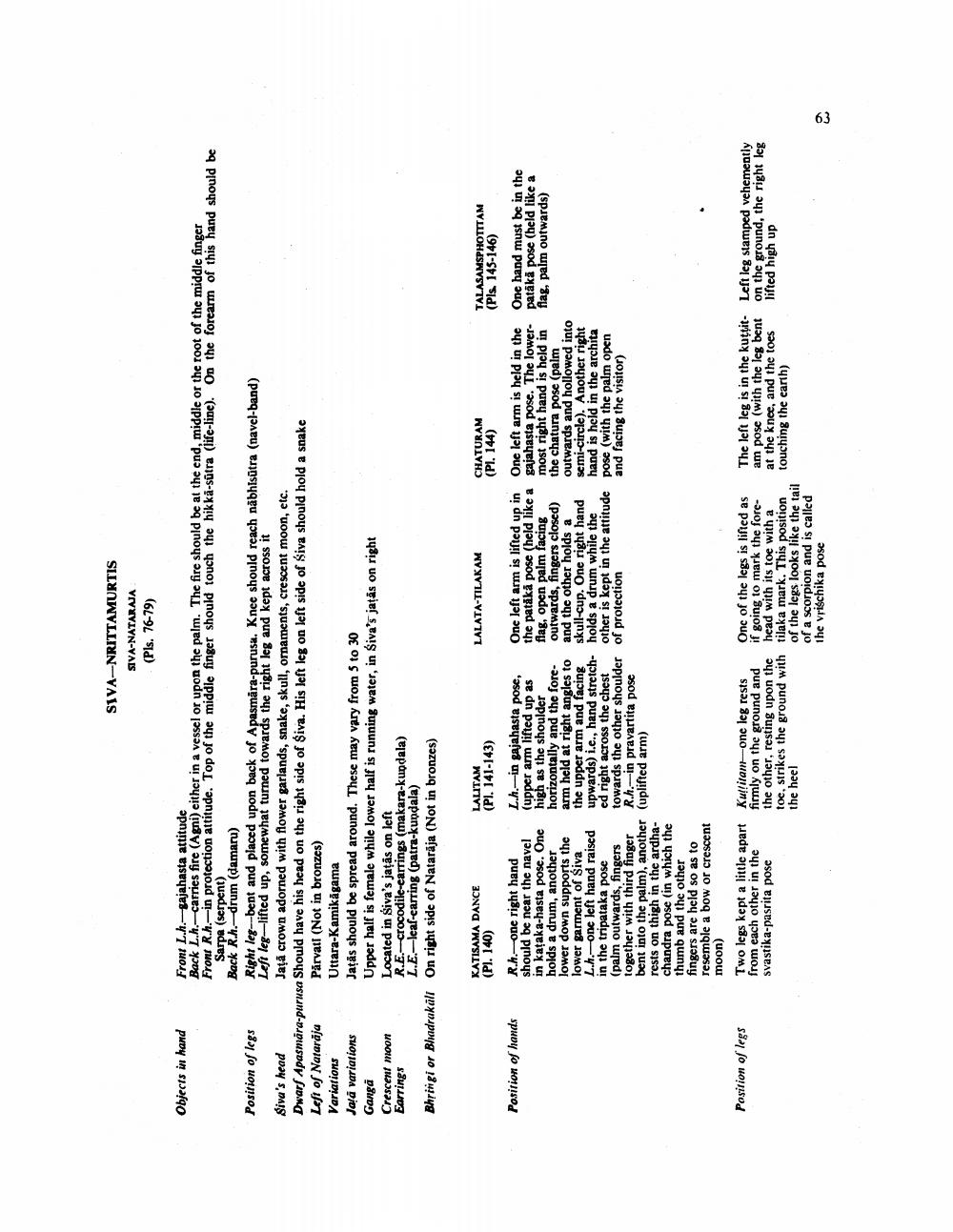________________
Objects in hand
Jață variations
Ganga
Crescent moon Earrings
Bhringi or Bhadrakall
Position of hands
Position of legs
Siva's head
Jaţă crown adorned with flower garlands, snake, skull, ornaments, crescent moon, etc.
Parvati (Not in bronzes)
Dwarf Apasmara-purusa Should have his head on the right side of Siva. His left leg on left side of Siva should hold a snake Left of Nataraja Variations
Uttara-Kamikäāgama
Jațăs should be spread around. These may vary from 5 to 30
Upper half is female while lower half is running water, in Siva's jatas on right
Located in Siva's jatās on left
R.E. crocodile-earrings (makara-kundala)
Position of legs
Front L.h.-gajahasta attitude
Back L.h.-carries fire (Agni) either in a vessel or upon the palm. The fire should be at the end, middle or the root of the middle finger Front R.h.-in protection attitude. Top of the middle finger should touch the hikka-sutra (life-line). On the forearm of this hand should be Sarpa (serpent)
Back R.h.-drum (damaru)
Right leg--bent and placed upon back of Apasmara-purusa. Knee should reach näbhisūtra (navel-band)
Left leg-lifted up, somewhat turned towards the right leg and kept across it
L.E.-leaf-earring (patra-kundala)
On right side of Nataraja (Not in bronzes)
KATISAMA DANCE (Pl. 140)
SIVA-NRITTAMURTIS
SIVA-NATARAJA
(Pls. 76-79)
R.h. one right hand should be near the navel in kataka-hasta pose. One holds a drum, another lower down supports the lower garment of Siva L.h.-one left hand raised in the tripataka pose (palm outwards, fingers together with third finger bent into the palm), another rests on thigh in the ardhachandra pose (in which the thumb and the other fingers are held so as to resemble a bow or crescent moon)
Two legs kept a little apart from each other in the svastika-pasrita pose
LALITAM
(Pl. 141-143)
L.h.-in gajahasta pose, (upper arm lifted up as high as the shoulder horizontally and the forearm held at right angles to the upper arm and facing upwards) i.e., hand stretched right across the chest towards the other shoulder R.h.-in pravartita pose (uplifted arm)
Ku!!itam-one leg rests firmly on the ground and the other, resting upon the toe, strikes the ground with the heel
LALATA-TILAKAM
One left arm is lifted up in the patākā pose (held like a flag, open palm facing outwards, fingers closed) and the other holds a skull-cup. One right hand holds a drum while the other is kept in the attitude of protection
One of the legs is lifted as if going to mark the forehead with its toe with a tilaka mark. This position of the legs looks like the tail of a scorpion and is called the vrischika pose
CHATURAM
(Pl. 144)
One left arm is held in the gajahasta pose. The lowermost right hand is held in the chatura pose (palm outwards and hollowed into semi-circle). Another right hand is held in the archita pose (with the palm open and facing the visitor)
The left leg is in the kuttitam pose (with the leg bent at the knee, and the toes touching the earth)
TALASAMSPHOTTTAM (Pls. 145-146)
One hand must be in the patākā pose (held like a flag, palm outwards)
Left leg stamped vehemently on the ground, the right leg lifted high up
63




